Whether you’re a newlywed or have been lighting candles for decades, you’ll find something inspiring and enlightening in this Shabbos Candlelighting guide.
Adapted from the Eishes Chayil candlelighting Treasury, Artscroll Mesorah Publications
The bracha, impact, and merits of lighting the Shabbos candles
- Shabbos is the source of all blessing, it is the mekor haberacha. It is the women’s candlelighting that ushers in the Shabbos and heralds blessing to her home and family. It is these holy Neiros that creates a barrier between the weekday and the Shabbos, a boundary between the mundane and the holy.
- One who is careful and beautifies the mitzvah of neiros Shabbos will merit children who are Torah scholars as the posuk (Mishlei 6:23) says Ki Ner Mitzvah V’Torah Ohr” –through the mitzvah of ner one will merit the light of Torah (Shabbos 23b; Tur §263)
- Through lighting candles, women bequeath their husbands long life and, therefore, they must be meticulous that this mitzvah be performed with utmost care and concentration (Zohar Bereishes 48b)
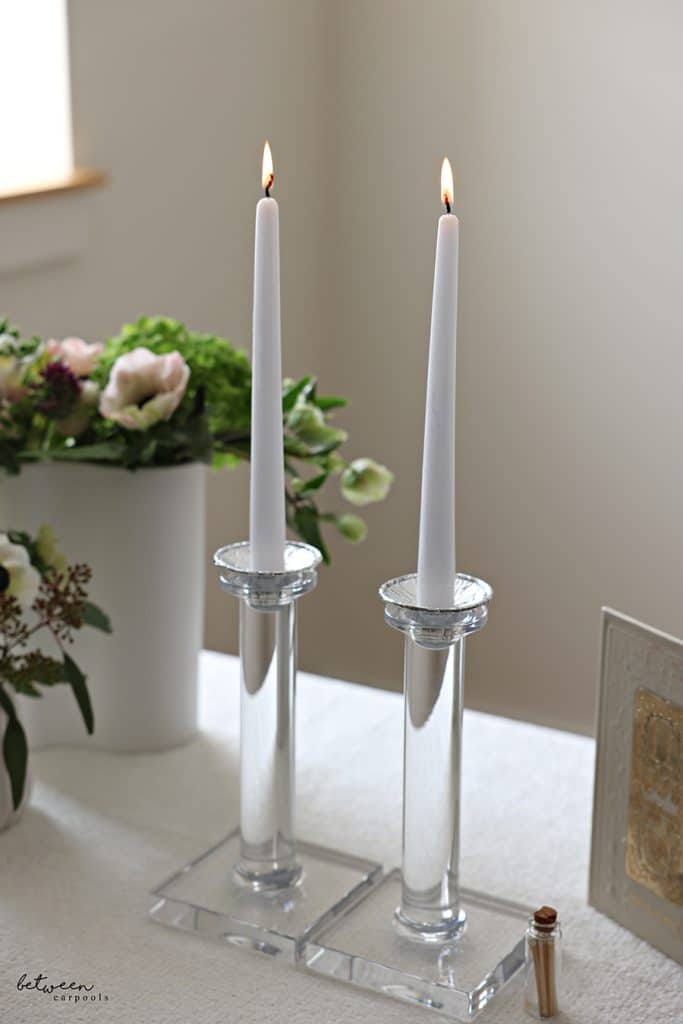
- In the merit of lighting Shabbos candles, one will merit to see the lights of Zion and Yerushalayim in the coming Redemption (Yalkut Shemoni, Behalosecha §719)
- The Shabbos candles place us under Hashem’s protective shield so that the home is guarded and its atmosphere is infused with joy and peace (Siduro Shel Shabbos Shoresh 2, 1:8)
- Hashem says to His people, the Jewish Nation, “If you are careful to guard the mitzvah of Neiros I will guard your Ner [your neshama which is called a Ner] (Shabbos 32a).
- One who lights the Shabbos candles is as precious and dear to Hashem as Aharon the Kohen Gadol lighting the Menorah in the Mishkan (Kedushas Levi, Chanukah §3)
- It was in the merit of the Jewish people’s staunch adherence to the mitzvah of Shabbos candles that they merited to defeat the vast Greek armies and to find one remaining pure jug of oil to be used for the Menorah in the Bais Hamikdosh. It was these events that were later memorialized into the holiday of Chanukah. (Kedushas Levi, ibid)
Why we light
- Kavod Shabbos– Lighting candles is a means of fulfilling the mitzvah of honoring the Shabbos, a mitzvah derived from the posuk (Yeshaya 58:13): לקדוש ה’ מכובד, [If you proclaim…] the hold [day] of Hashem “honored.” The presence of candles creates an aura of respect and importance, thereby adding to the prestige of Shabbos (Shabbos 24b; Rambam Shabbos 30:5; See Chinuch, Mitzvah 98).
- Shalom Bayis-The presence of light prevents people from stumbling in the dark and becoming irritated at one another thereby promoting peace and joy in the home. Peace and joy are an ever-integral component of Shabbos. There should be light in all rooms that one intends to enter on Shabbos (Shabbos 25b).
- Oneg Shabbos -Having light increases one’s enjoyment of Shabbos and Yom Tov, as one can see and thereby enjoy his food. Someone stricken with visual impairment does not have the same pleasure from food as someone with full eyesight. Hence, one should ensure that the Shabbos candles will burn for the duration of the Friday night meal (Shulchan Aruch 263).The Midrash sources the obligation to light Shabbos candles in the posuk from the prophet Yeshaya (58:13) וקראת לשבת ענג-Proclaim the Shabbos “a delight.”
Preparing the candles
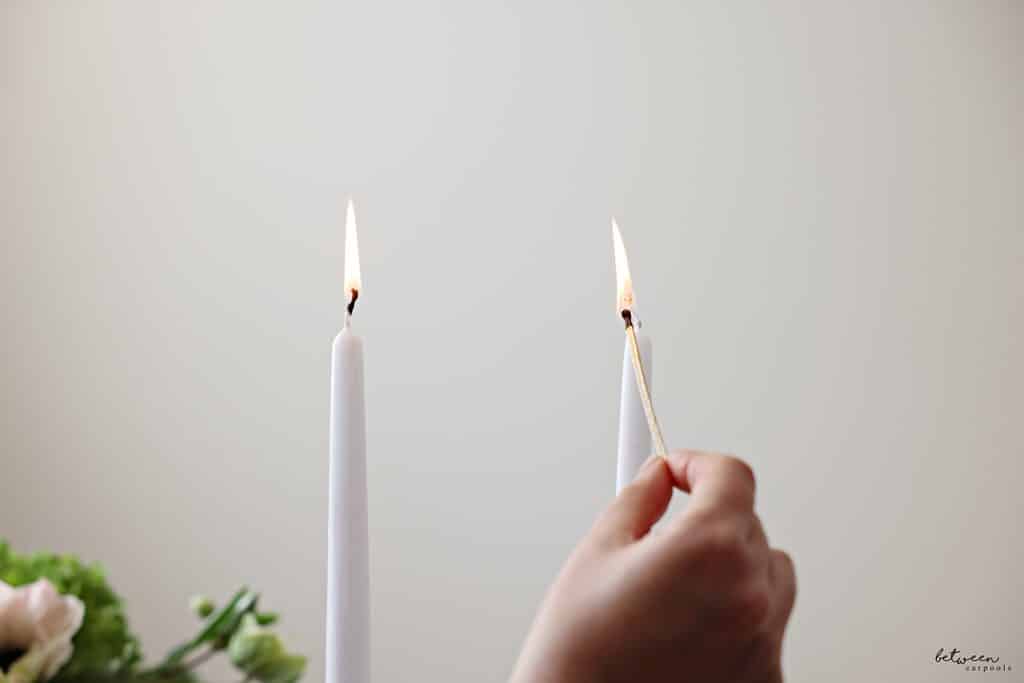
- Once a woman lights the Shabbos candles, she has accepted Shabbos and may no longer perform any melacha– prohibited work. Hence, all melacha must be completed before lighting the Shabbos candles. In unusual circumstances, where this is not feasible, a competent halachic authority should be consulted before the candles are lit.
- Women who are planning on davening Mincha should do so prior to lighting candles (M.B. 263:43).
- It is the proper custom that women light the Shabbos candles dressed in their Shabbos finery, as it is at this point that they usher in the holiness of Shabbos. However, hastening to don Shabbos clothing should not come at the expense of lighting candles on time (M.B. 262:11).
- It is commendable that prior to lighting candles women give charity (Kitzur Shulchan Aruch 72:2).
- In many communities, the man of the household prepares the Shabbos candles. Some have the custom that the man lights the candles and then extinguishes them (M.B. 264:28).
- One of the main functions of the Shabbos candles is to supply light for the Friday night meal. Hence, the candles should be placed on or near the table where the meal will be eaten. If this is difficult one should consult a Rav as to their correct placement (M.B. 263:45).
When to light?
- The generally accepted time for lighting the Shabbos candles is eighteen minutes before shkiah, sunset. If one is delayed, the candles may still be lit up to shkiah. The custom in Jerusalem is to light Shabbos candles forty minutes before sunset; some other communities have their own specific customs.
- The earliest one may accept Shabbos is from plag hamincha and onwards, which is one-and-a-quarter halachic hours before shkiah (sunset). A Jewish calendar or the MyZmanim website can be used to determine this exact time as well as your locales time for candlelighting.
Number of Candles
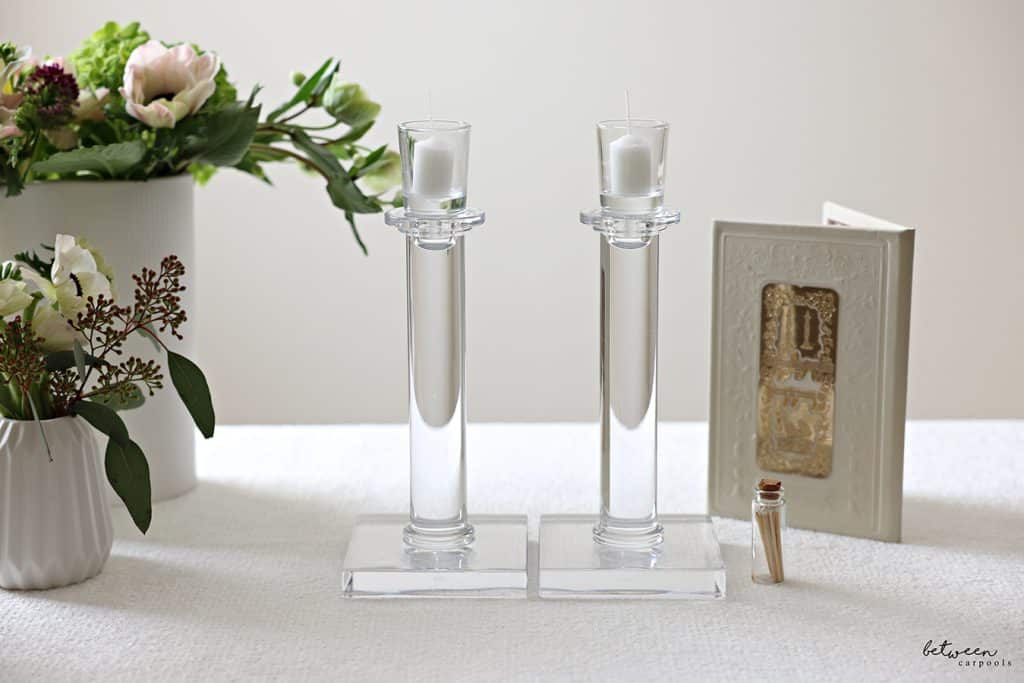
- The prevailing custom is to light a minimum of two candles, one reflecting the mitzva of Zachor es Yom HaShabbos, to remember and honor the Shabbos, and one reflecting Shamor, the mitzvah to safeguard and adhere to its laws. Additionally, the two candles are symbolic of the neshama yeseirah, the extra neshama that one is gifted with on Shabbos (Mateh Moshe §414). The two candles are also symbolic of a husband and wife. The numerical value of the word נר is 250. The numerical value of the words נר plus נר, symbolic of the two candles, is 500, which equals the total combined limbs of a man (248) and a woman (252) (Elya Rabba 263:2).
- In extenuating circumstances, a woman may fulfill her obligation by lighting only one candle (Shulchan Aruch 263:1). If no candles are available (such as in a hospital or hotel), one should consult a Rav to ascertain if a blessing can be recited upon turning on the electric lights.
- Many women have the custom to add a candle upon the birth of each child, so that the additional light should serve as a merit that the child’s Torah learning light up the world (Likutei Maharich). When a woman is not home for Shabbos or Yom Tov, the custom is that she lights only two candles, even if she lights more when she is at home (Shmiras Shabbos K’Hilchasa, vol. 2, 43:3). Some have the custom to light seven candles, corresponding to several important “sevens:” The seven days of the week, the seven men called up to the Torah on Shabbos, and the seven candles lit on the Menorah in the Bais Hamikdosh. Others light ten candles corresponding to the Ten Commandments.
- Shabbos candles must burn until the start of the Friday night meal. Optimally they should burn for the entire duration of the meal.
What to light with?
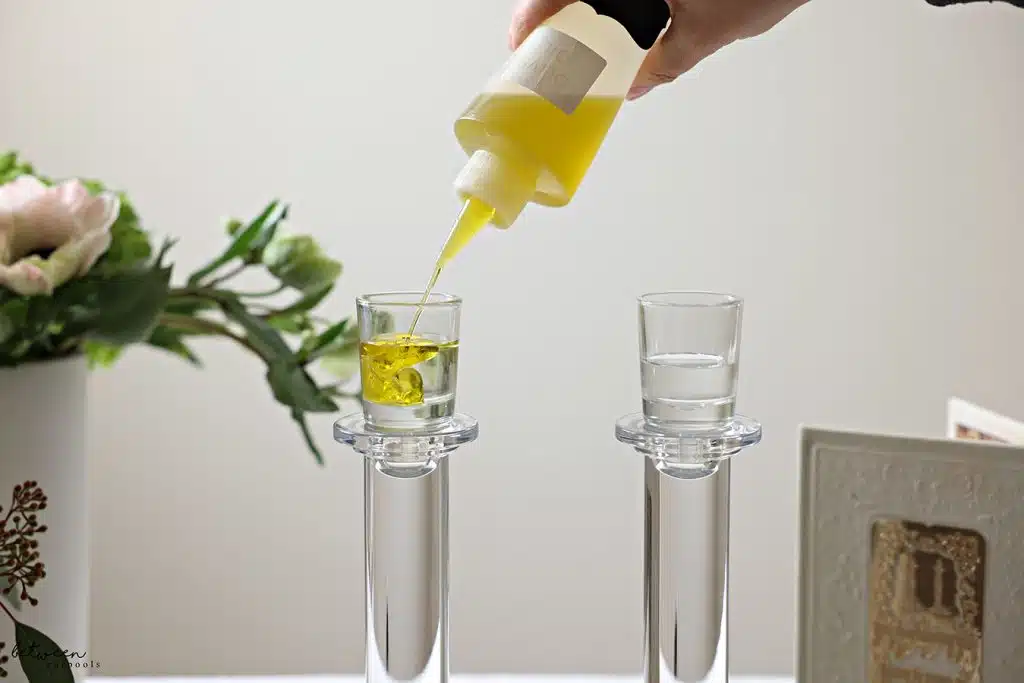
- The Pele Yoetz writes (Ner Shabbos): “It is well known that one who is careful with Neiros Shabbos will merit children who are Torah scholars. Careful with this mitzvah means that the candlestick one is lighting with should be beautiful and clean, one should light with olive oil…and if with all mitzvos one should make every effort to perform the commandment in the finest manner to bring joy to Hashem then certainly [one should beautify] this mitzvah in which the reward (of children) is publicized as one would give away all the money in his home so that his children merit the crown of Torah.” As to why specifically olive oil is the chosen fuel of choice for many, the Talmud tells us that one who lights candles merits children who are Torah scholars. The Talmud compares the Torah scholar to olive oil.
Sefer Chassidim (272) recounts of a person who lived a very long life and they found the only extra merit he had was that he lit the Shabbos candles with olive oil. Some learn that the Talmud’s (Shabbos 23b) blessing of one who is careful to light Shabbos candles will merit children who are Torah scholars refers to those who light with olive oil (Eshel Avraham 263:1; Machzik Bracha 264:2). The Midrash (Chodosh page 257) writes that olive oil is unique in that it separates itself from the liquids that surround it and rises to the top. So, too, as long as the Jewish people separate and distinguish themselves from the gentile ideals and practices that surround them, they will merit to rise to the top. (See Shir Hashirim Rabbah, 1:3).
- Many have the custom to light with olive oil as oil burns the brightest (Shulchan Aruch 264:6). Nevertheless, presently where our wax and paraffin candles burn efficiently and produce a bright flame many have the custom to light with these. One should follow her respective family custom. (M.B. 264:23)
The blessing:
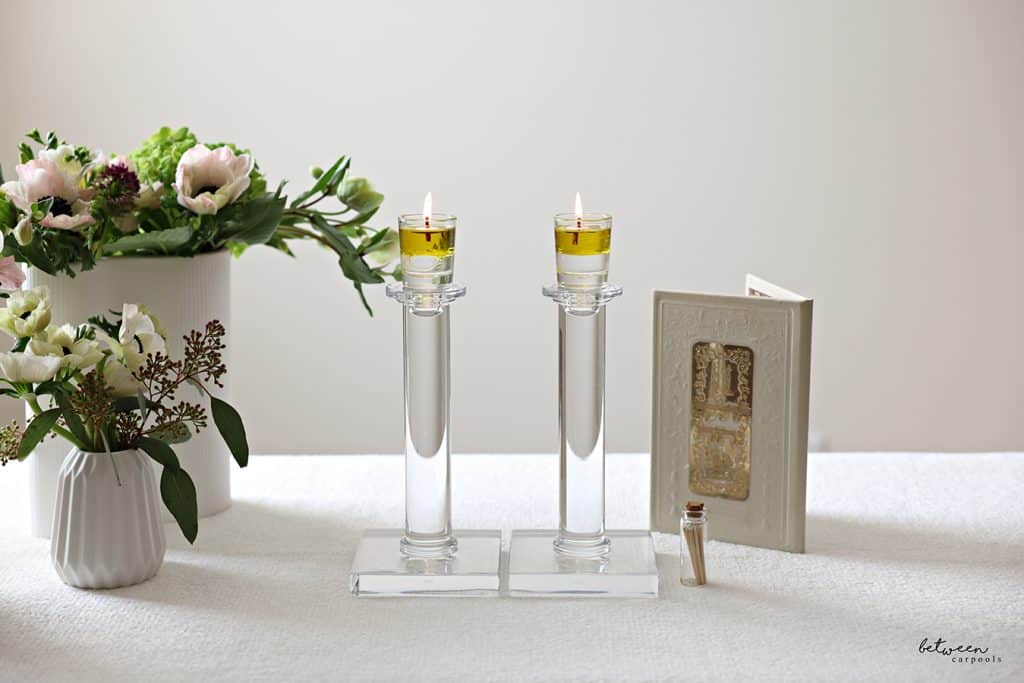
On the eve of Shabbos, the candles are lit, the match or lighter placed down, the eyes are covered (some have the custom to wave their hands in front of the candles before covering their faces) and the following beracha is recited:
בָּרוּךְ אַתָּה ה’ אֱלֹהֵינוּ מֶלֶךְ הָעוֹלָם אֲשֶׁר קִדְּשָׁנוּ בְּמִצְוֹתָיו וְצִוָּנוּ לְהַדְלִיק נֵר שֶׁל שַׁבָּת:
Ordinarily, a bracha is recited prior to the performance of the mitzvah. Yet, the instance of Hadlokas Neiros and its blessing is unique. If the blessing on the Shabbos candles would be recited first this would constitute an acceptance of the Shabbos and it would be forbidden to then kindle the Shabbos candles. In order to satisfy all halachic concerns, the candles are lit first, the eyes are covered so as not to benefit from the light, the bracha is then recited, the eyes uncovered so that only then does one benefit from the candles. It is thus as if the blessing preceded the mitzvah (the process for Yom Tov candlelighting is different than the above).
Tefillah to be recited after kindling the Shabbos candles
candlelighting is a highly auspicious time for women’s tefillos. Rabbeinu Bachya (Yisro 19:3) explains: It is the mother, who is generally in the home with her children, who through her power of love and emotion is the one to influence them to learn and live a life of Torah from the very youngest of ages. Because of this responsibility, it is meritorious for a woman to pray to Hashem at the time of candlelighting, a mitzvah imparted especially to her, that she merit children who light up the world with their Torah study. Tefillos are highly valuable and accepted by Hashem at the time of a mitzvah performance. Thus, in the zechus of lighting Shabbos candles she should merit children filled with Torah which are, likewise, called a light, as the posuk (Mishlei 6:23) says Ki Ner Mitzvah V’Torah Ohr.
It is the women’s Shabbos candles that ushers Shabbos into the home. The Shabbos which is the day of emunah, the time where all worries are stowed away and our relationship and reliance on Hashem refreshed and fortified. The more one trusts in Hashem the closer she is to Him and the more propitious and dearer her prayers are. It is, therefore, a special time for women to pray for themselves, their families, and for anything that they need after kindling the Shabbos candles, a demonstration of emunah and a time of extreme closeness to Hashem.
The following tefillah is customarily recited:
יְהִי רָצוֹן מִלְּפָנֶיךָ יְדֹוָד אֱלֹהַי וֵאלֹהֵי אֲבוֹתַי. שֶׁתְּחוֹנֵן אוֹתִי (וְאֶת אִישִׁי וְאֶת בָּנַי וְאֶת אָבִי וְאֶת אִמִּי) וְאֶת כָּל קְרוֹבַי. וְתִתֶּן לָנוּ וּלְכָל יִשְֹרָאֵל חַיִּים טוֹבִים וַאֲרֻכִּים. וְתִזְכְּרֵנוּ בְזִכְרוֹן טוֹבָה וּבְרָכָה. וְתִפְקְדֵנוּ בִּפְקֻדַּת יְשׁוּעָה וְרַחֲמִים וּתְבָרְכֵנוּ בְּרָכוֹת גְּדוֹלוֹת. וְתַשְׁלִים בָּתֵּינוּ. וְתַשְׁכֵּן שְׁכִינָתְךָ בֵּינֵינוּ. וְזַכֵּנִי לְגַדֵּל בָּנִים וּבְנֵי בָנִים חֲכָמִים וּנְבוֹנִים. אוֹהֲבֵי יְיָ. יִרְאֵי אֱלֹהִים. אַנְשֵׁי אֱמֶת. זֶרַע קֹדֶשׁ בַּיָי. דְּבֵקִים וּמְאִירִים אֶת הָעוֹלָם בַּתּוֹרָה וּבְמַעֲשִֹים טוֹבִים וּבְכָל מְלֶאכֶת עֲבוֹדַת הַבּוֹרֵא. אָנָּא שְׁמַע אֶת תְּחִנָּתִי בָּעֵת הַזֹּאת. בִּזְכוּת שָֹרָה וְרִבְקָה וְרָחֵל וְלֵאָה אִמּוֹתֵינוּ. וְהָאֵר נֵרֵנוּ שֶׁלֹּא יִכְבֶּה לְעוֹלָם וָעֶד וְהָאֵר פָּנֶיךָ וְנִוָּשֵׁעָה. אָמֵן:
Extra Inspiration: Every Child a Special Light
Many have the custom to light an additional candle (besides the customary two) for every child born into the family. Rabbi Abraham J. Twerski M.D. explains that the presence of every additional candle brings more light into the home. The message to our children is that no matter who you are, what your grades are, or how you behave, Mommy lights a candle for you because you bring a special and unique brightness and joy into this home and into the world. In today’s world where feelings of inadequacy and inferiority are all too common, this message of every child’s Shabbos candle bringing a unique light into the home and the world is ever so important and illuminating. (Generation to Generation, page 75)
There is perhaps no better time to inculcate this message within us and relay it to our children than on Shabbos. Children at any age thirst for their parents’ positive attention, unconditional love, and recognition. Providing children with the feeling that they are unique and special is lifesaving and life building medicine for the soul and body. Children who are made to feel special, unique, and loved are invariably more confident, more secure, and have higher aspirations and self-esteem for the life ahead of them.
Mothers should always look for the good in their children. Rebbetzin Leah Kolodetsky, the daughter of Rav Chaim Kanievsky suggests that if you’re looking for a segulah for good children, give every child two compliments each day. This will ensure with Hashem’s help that your children will be healthy in both body and soul. Complimenting a child, and in fact anyone, is like water for a plant, it provides nutrients, energy, and sincere growth.
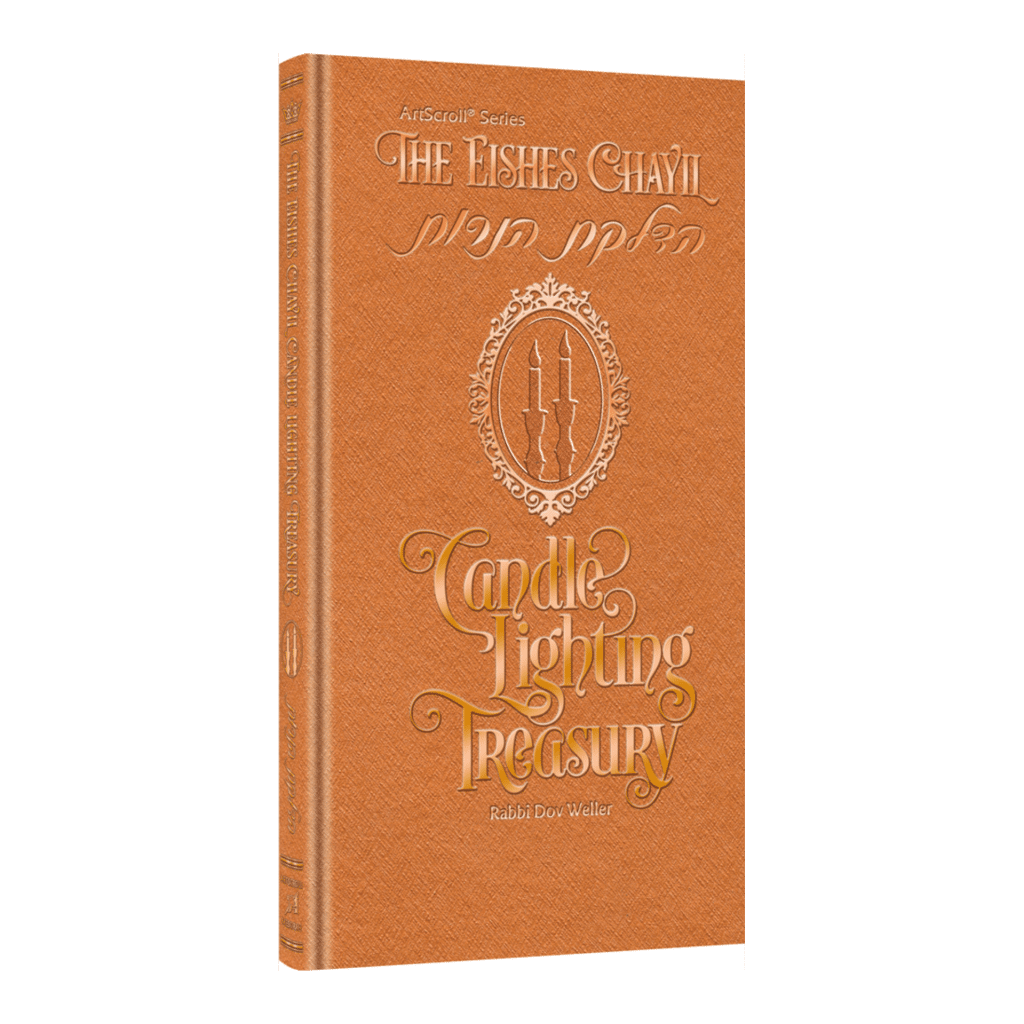
Find more inspiring content on Shabbos candlelighting in The Eishes Chayil Hadlakas Neiros Candle Lighting Treasury.


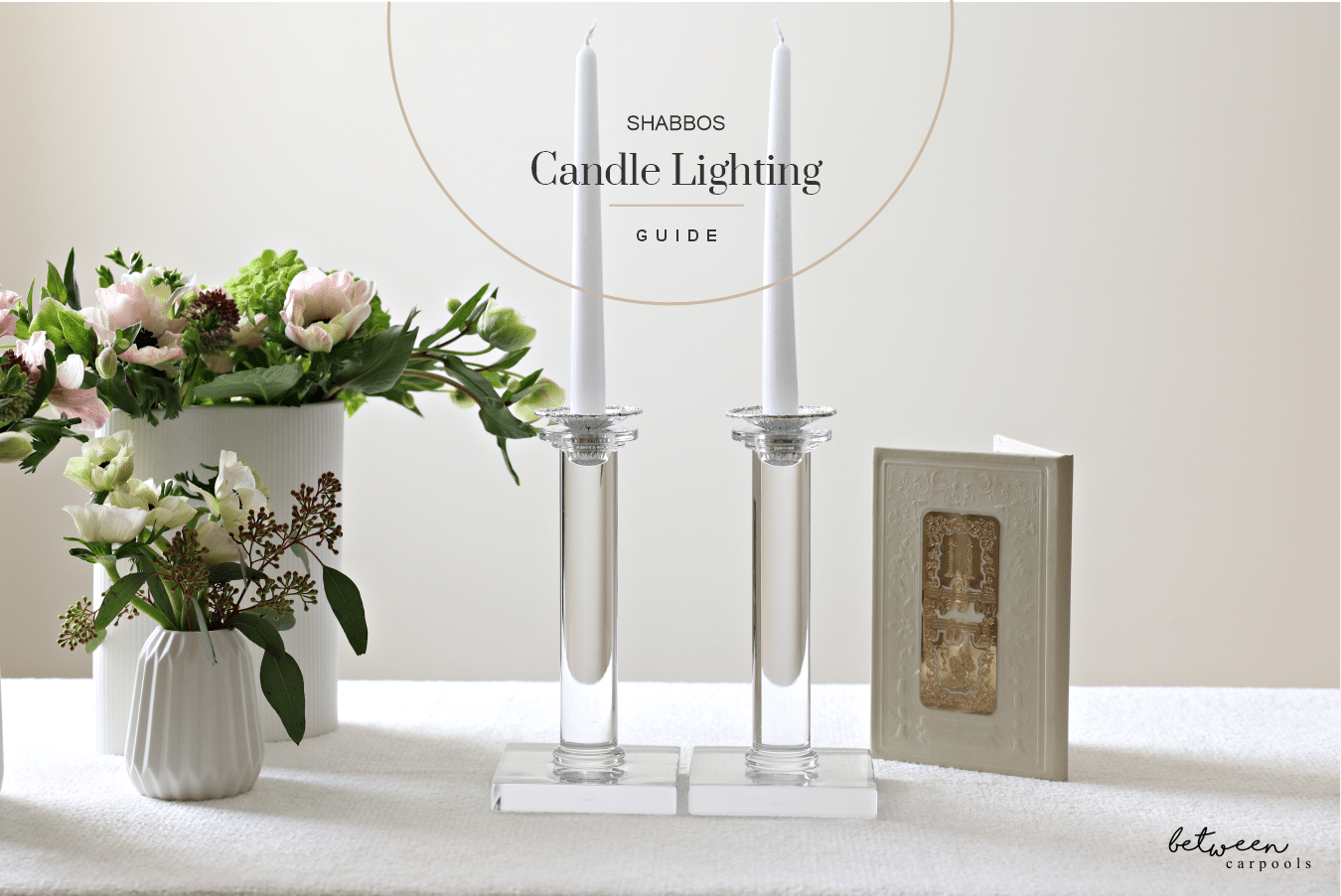
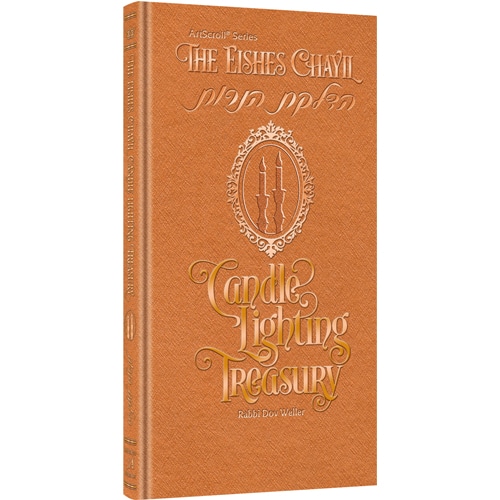

Beautiful post, thank you so much!
a nice refresher.
Thank you so much!!! Much needed inspiration on the perfect topic
Thank you for a beautiful article. I always put the match down but I’ve seen people blow it out. Is this allowed? Is this topic discussed in the book?
I once asked this question and I was told that I’m allowed to blow it out because before making the brachos I’m not mekabel Shabbos yet. But, as usual I would say ask your own rav.
Such a beautiful post, thank you!
Beautiful post.
Putting down a match as opposed to blowing it out is probably because al pi Kabbalah one should not blow out a flame. I shake the match then dispose before reciting Bracha.
Beautiful article! Very inspiring!
BezH in going to try and make sure my candlesticks are polished! And not by my cleaning lady – I want to do the mitzvah!
I just want to note there is a Sephardi custom to say the beracha – light – and then put the match down.
I just didn’t want Sephardi to think they r doing it wrong… but there are some Sephardi who do it the way mentioned in the article too
I like when people write the Ashkenazie and Sephardi customs…
Thank you so much for this !
On yt you make the Bracha first and then you light. On shabbos you light and then cover your eyes when you say the Bracha. The reason for that is because you are really supposed to say the Bracha first but then you will already be mekabel shabbos so you cover your eyes so that you shouldn’t have hana’ah from the flames before reciting the Bracha. On yt you don’t cover your eyes because you say the Bracha first….
Hi I know it’s not the point of the article, which was super informative, but where can I purchase those candlesticks? They are just what I am looking for!
These were purchased from Set your Table over a decade ago! I’m afraid they are discontinued.
Wow so beautiful! Would you know if I’m allowed to drink a coffee or eat something right after candlelighting?
I was told I can’t even drink water after candlelighting until kiddush. You can, though, make your own kiddush before your husband (or whoever is making kiddush) comes home and then eat/drink. But as always, ask your own LOR 🙂
Thank you for this beautiful post, very inspiring! I especially like the last paragraph from R’ Twerski, so true!
The Lubavitcher Rebbe encouraged all girls over 3 years of age to light their own candle too, this adds in light in the world before the coming of mashiach, especially in these times when we need more light!
beautiful and FYI the neronim candles that go in the glass cups they now sell made out of olive oil! they’re yellow.
Just a note: the Sefaradi custom, even for Shabbat candles is to say the beracha and then light.
As usual this article does not mention the differences in Sephardi Halacha and Minhagim. There should be a disclaimer because there are several significant differences.